The Spring 2023 Manga Guide
Junji Ito's Tombs
What's It About?
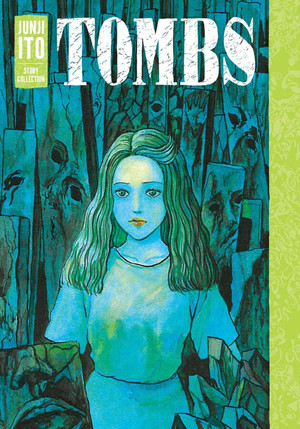
Countless tombstones stand in rows throughout a small community, forming a bizarre tableau. What fate awaits a brother and sister after a traffic accident in this town of the dead? In another tale, a girl falls silent, her tongue transformed into a slug. Can a friend save her? Then, when a young man moves to a new town, he finds the house next door has only a single window. What does his grotesque neighbor want, calling out to him every evening from that lone window?
Tombs has story and art by Junji Ito, with English translation by Jocelyne Allen with lettering and touch up by Eric Erbes. Viz released its first volume both digitally and physically on March 28 for $13.99 and $25.00 respectively.
Is It Worth Reading?
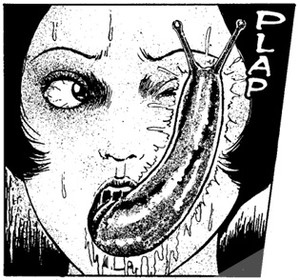
Christopher Farris
Rating:
There is always another Junji Ito collection. And they can't all be winners now, can they? If you're familiar with the man's work, then a passing glance over the table of contents for Tombs will let you know that you are getting some bangers in this one, including "Slug Girl" and "The Window Next Door," some personal favorites of mine. But those are only some of the entries in this 300+ page collection, with several others are hardly standard-bearers for Ito's body of work.
Ito's horror indulgences have long gotten by on the strength of singular ideas, weird concepts that he can page out and finish off by landing on some wild artistic punchline. The problem is that so many of the ideas in Tombs feel undercooked. What if there were a big weird fish? What if there were a weird statue? The titular opening tale itself is mostly an I Know What You Did Last Summer sort of deal by way of "What if people decomposed weirdly?". It's okay, but perhaps not the most worthy of being the title story for this collection. Others, like "Clubhouse," mostly seem to wander around as parboiled horror-mysteries before coasting to an unsatisfying finish. Things aren't even paced out with much of Ito's usual humor indulgences. Only "Bronze Statues" really plays with that element, and then even its ending feels more like a shrug than a mic drop.
There are some stronger stories, particularly as longer ones fill out the latter half of the book. "The Strange Tale Of The Tunnel" honestly makes the most clear centerpiece of this collection, carrying an ongoing sense of curious dread before escalating in some satisfyingly wild ways. "Floaters," meanwhile, actually eschews a lot of Ito's more expected horrific imagery to tell something more simply based on ideas. It makes for a compellingly weird, sad little story. The last story in the collection, "The Bloody Story Of Shirosuna," finally really delivers on what we expect of Ito's bizarre ideas for imagery, but might be too much of a slow burn, and the ideas may not be explored enough. There are plenty of other, more consistent collections from Junji Ito out there, so unless you're absolutely a completist, you probably don't need to prioritize Tombs here.
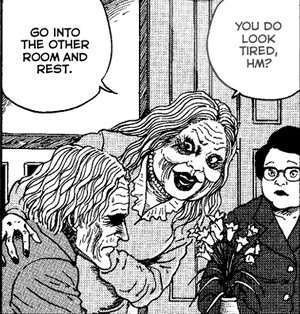
Rebecca Silverman
Rating:
There's almost always a Junji Ito short story collection in the Spring Manga Guide, but they're usually a bit more striking than this one. Not that there's anything objectively wrong with Tombs—it features almost 350 pages of Ito's stock-in-trade: eerie rural villages, teens with unhealthy obsessions, and monsters that are amalgamations of human flesh and blood. The issue is more that these feel a little bit too familiar, like Ito's not really trying any new twists on his usual formula. They're still good, just not as striking as you'd expect from manga's master of horror.
Of the included tales, the first and the last are probably the most interesting. The title story, about a town where humans immediately turn into grave markers where they die, takes the omnipresent fear of death and makes it into something truly inescapable. Instead of being neatly tucked away in manicured and tended graveyards, the presence of gravestones in people's homes, the middle of the road, or anywhere else death occurs neatly taps into that staple of horror fiction, that almost anywhere can be a place where someone died. It makes hiding crimes much, much harder, and that gels with the inevitability of death pretty well. It also relies more on terror (psychological fear) than horror (gruesomeness) in a way that is effective.
The final story is on the opposite end of the spectrum. It plays with legends of sacrificial maidens in a much grimmer way than we often see, taking place in a remote village where years of ritual sacrifice has tied the villagers to the town's land in a truly awful way. It feels more familiar than some of the other stories, but it blends Ito's signature body horror with mad science (something that the story about the bronze statues also does) solidly. The same can be said for most of the book: nothing stands out too much, but it's still a solid offering for Ito fans. If it isn't quite as good as some of his other books, that still means that it's a cut above a lot of horror manga out there.
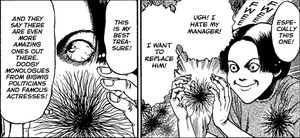
Jean-Karlo Lemus
Rating:
Yep, this sure is a Junji Ito collection!
I'm trying not to be sarcastic, this really is a great collection of horror stories from one of the best-known horror mangaka around. And each story is definitely great: terrors abound in modern society, from the creepy neighbor who's constantly trying to get your attention to the scoundrel who's constantly collecting dirty little secrets from his peers. I don't wanna snub his work by claiming his stories are all “Weird thing happens, person investigates, then the spoopy thing does the spoop”, it's just a little hard to rate an anthology as a collection. For what it's worth, the collection hits far more than it misses: the titular Tombs is packed with supernatural imagery, the confrontation of the grotesque, and people's hidden sins coming back in full force. Floaters is also right up there, with the addition of a particularly poignant and heartfelt ending. Bronze Statue also tells a tale of both inner and outer ugliness, with a fittingly tantalizing punishment for our main character. The lesser stories in this collection aren't bad so much as they're just not as good, with climaxes and endings that don't quite shock you as hard as the others do.
Ito's iconic art style is in full effect here, loaded with grotesque bodies twisted and contorted into the nastiest nasties you'll ever see. He's phenomenal as ever at iconography that'll stick with you, like a snail using a woman's head as a shell or the remains of a group of women forever frozen in plaster. These stories feel timeless; they could have taken place in the '50s just as easily as they could have taken place in the 80s or now. Like any good horror story, these tales all take place in the next town over, or at the house at the end of the road.
Junji Ito fans will pick this up sight unseen, they'll be well-served by it. Anyone who hasn't already been introduced to Ito would find a great starting point here. And heck, if you're just a horror enthusiast, why haven't you picked up a Junji Ito work? Strongly recommended.
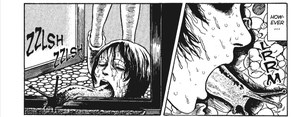
MrAJCosplay
Rating:
It goes without saying that the artwork in this book is gorgeous and an absolute highlight. Backgrounds are incredibly detailed to the most meticulous level, with textures that can capture even the most subtle elements. I have to give Junji Ito credit, I have read dozens of his stories at this point, and I still squirm in my seat. However, while the artwork is consistent, not all of his stories have the same quality in their overall narrative intrigue. Some stories can be incredibly basic with your classic “bad things happen to bad people” message. In contrast, others can be surprisingly thought-provoking about how we as human beings see the world or interact with each other.
Even with the incredibly detailed artwork, it can get frustrating when it feels like Ito is building up to something specific but immediately cuts the story abruptly once we get to a particular scene. For example, some stories are about an impartial observer just witnessing bad things happen to another character. Then when that observer gets dragged into that situation in a specific and disturbing way through no fault of their own, the story just…ends. Or maybe it's better to say the story stops, and then we immediately move on to the next one, with usually a narration bubble to give us what feels like an obligatory closing statement. If you're a horror fan or have a pension for disturbing imagery, then chances are this is already in your online shopping cart. For those that are more curious, I recommend the first three stories and seeing how those make you feel.
discuss this in the forum (33 posts) |
back to The Spring 2023 Manga Guide
Seasonal homepage / archives